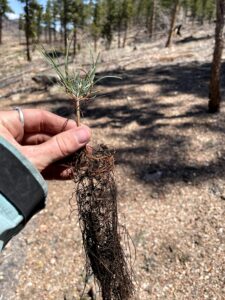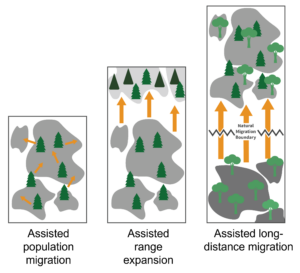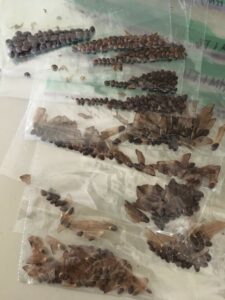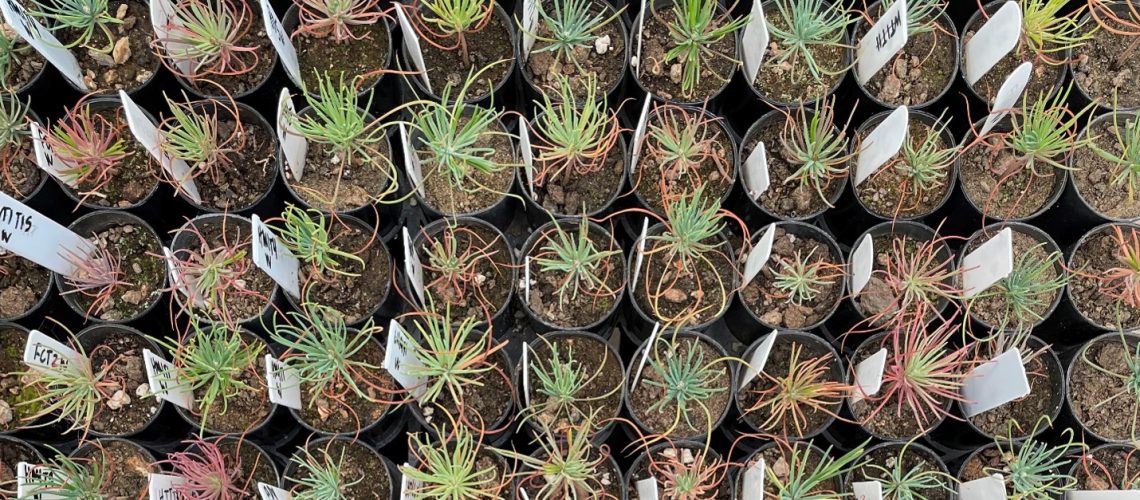Guest Post by Katie Nigro, 2021-2022 Sustainability Leadership Fellow, and Ph.D. Candidate in the Department of Forest and Rangeland Stewardship and the Graduate Degree Program in Ecology at Colorado State University
As a nature-loving hiker who loves to explore wild places far from housing developments, I entered my graduate program in ecology bristling at the thought of human intervention in “nature” and excited for the opportunity to learn the intricacies of the natural world, without leaving a trace. Four years later and I find myself advocating for the use of assisted migration – or the moving of species or populations outside of their current distribution to areas that will suit them better in the future. Many argue that this is one of the most intrusive things we can do to combat climate change. So, what happened to that leave-no-trace nature lover?
Humans, especially those trained in the Western science tradition like me, have a long history of mentally separating ourselves from nature, thinking that we are somehow different from the many species we co-inhabit this earth with. But there is no place you can go on Earth that has not been modified by humans in some way – and we have been modifying our environments for tens of thousands of years through purposeful burning, species introductions & extinctions, agriculture, and now the rapid release of greenhouse gases causing global climate change. We interact with nature everyday – all the materials used to build our homes and technology were once found in trees, rocks, and rivers, and our backyards are full of plants and animals. In this new era of ubiquitous human influence around the world, perhaps the best way to care for and protect nature is to intervene in it.

As human-caused climate change continues to warm the planet, plants and animals may no longer be suited to the climate conditions where they currently grow. For trees, this is an especially hard problem because they live a long time (100’s to 1,000’s of years!) and cannot just get up and walk away to find cooler ground. Although there is nothing much to do for plants that are already in the ground, getting the next generation of plants (or seeds) to places better suited for their survival can still allow the species to persist. Seeds are dispersed in many ways, including by wind, water, animals, and gravity, but with the rapid pace of climate warming, plants will need to disperse their seed longer distances to be able to keep up with the change. One study estimated that trees will need to migrate at least 1,000 meters (0.6 miles) each year to keep up with future climate warming, despite historical migrations only occurring at 10% or less of this speed (Aitken et al., 2008). Hence, many tree species are not keeping pace with this rapid rate and may need our help to achieve these long-distance migrations.

Assisted migration is the term broadly used for the transfer of a species to a more climatically suitable area in order to protect the species from extinction due to climate change (Pedlar et al., 2012; Ste-Marie et al., 2011). There are several types of assisted migration. Assisted population migration is the act of taking seeds from one area where a species currently exists, usually that is hotter, and moving them to a cooler area that is predicted to become hotter in the future. This “pre-adapts” the individual trees at the site to the predicted future climate by bringing in some seeds that are already accustomed to warm temperatures. You could think of this like people from Arizona, who are used to the heat, moving up to Colorado in anticipation of future warming. They may be a little cold when they first get here, but they will be more prepared for the heat to come. Transferring seeds to areas where the species does not currently live, but is directly adjacent to where they live, is called assisted range expansion, and may help the species in moving to new areas that are nearby. Finally, assisted long-distance migration is when species are moved far away from their current home (Ste-Marie et al., 2012), as was done with the Florida torreya (Torreya taxifolia) in a citizen-initiated conservation effort that garnered quite a bit of controversy in 2008 . In forestry, the most common type of proposed species movement is assisted population migration, since many common tree species in the US are widespread and therefore have many populations from which seeds can be collected (Pedlar et al., 2012). Traditionally, the US Forest Service has restricted tree planting in National Forests to only those seeds that came from the surrounding geographic area, called the “seed zone”. However, with rapid climate change reducing the ability for species to deal with the climate where they live, using seeds from seed zones adapted to the future climate, rather than the current climate, has been suggested for reforestation change (Pedlar et al., 2012; Ste-Marie et al., 2011).
Though there were early fears about using assisted migration, the risks of not managing for climate change are beginning to outweigh the risk of intervening in where species live. Left to natural regeneration, tree species must be able to disperse to climatically suitable environments for present-day regeneration of seedlings and for long-term survival of adults. For species that are long-lived and have short dispersal distances, natural selection may be too slow to keep pace with rapid climate change (Renwick & Rocca, 2015). This could result in loss of biodiversity, forest productivity, and ecosystem services, with the possibility of a transition to non-forest (Parks et al., 2019; Pedlar et al., 2012).

The current barriers to implementing assisted migration include the established laws and attitudes about forest restoration in land management agencies and the logistical constraints of time, money, and personnel needed to plant the trees (Dumroese et al., 2015; Rehfeldt et al., 2014). Therefore, we need to prioritize areas where we can get the most bang for our buck in terms of forest restoration and climate adaptation. The western US continues to experience larger and more severe wildfires, leaving many areas devoid of live trees needed for seed production and regeneration (Coop et al., 2020). Given that the Forest Service already devotes part of its budget to reforest these lands after wildfire, we can harness this capacity to plant trees adapted to future climate, if federal policy shifts to allow seed sources from outside the current seed zone.
In British Columbia, Canada, the Ministry of Forests, Lands, Natural Resource Operations and Rural Development has already adopted climate-based seed transfer policy that allows for assisted migration. In the US, federal policy is not there yet, but many studies are being conducted to figure out how assisted migration may work for trees. The Adaptive Silviculture for Climate Change project is a collaboration among multiple sites across the US and Canada to test different management strategies for making forests better equipped for the climate changes to come. At one of these sites, the Cutfoot Experimental Forest in Minnesota, researchers planted ponderosa pine (Pinus ponderosa), which currently does not occupy any land in Minnesota, as a test of assisted long-distance migration (Muller et al., 2019). Although about half of the planted seedlings died, the ones that did survive grew more than the native species at the site. This indicates that ponderosa pine may be a viable option for replacing red pine (Pinus resinosa) as it gets too warm in Minnesota for the continued existence of red pine.
Ultimately the question of human intervention in the environment comes down to our values. What do we want our forests to look like in the future? If we want to continue to enjoy the majestic beauty, shade, clean water, and wood that trees provide, then we may need to help them pack their bags and move to areas where they can be as productive and healthy as possible.
References:
Aitken, S. N., Yeaman, S., Holliday, J. A., Wang, T., & Curtis-McLane, S. (2008). Adaptation, migration or extirpation: Climate change outcomes for tree populations: Climate change outcomes for tree populations. Evolutionary Applications, 1(1), 95–111. https://doi.org/10.1111/j.1752-4571.2007.00013.x
Coop, J. D., Parks, S. A., Stevens-Rumann, C. S., Crausbay, S. D., Higuera, P. E., Hurteau, M. D., Tepley, A., Whitman, E., Assal, T., Collins, B. M., Davis, K. T., Dobrowski, S., Falk, D. A., Fornwalt, P. J., Fulé, P. Z., Harvey, B. J., Kane, V. R., Littlefield, C. E., Margolis, E. Q., … Rodman, K. C. (2020). Wildfire-Driven Forest Conversion in Western North American Landscapes. BioScience, biaa061. https://doi.org/10.1093/biosci/biaa061
Dumroese, R. K., Williams, M. I., Stanturf, J. A., & Clair, J. B. St. (2015). Considerations for restoring temperate forests of tomorrow: Forest restoration, assisted migration, and bioengineering. New Forests, 46(5–6), 947–964. https://doi.org/10.1007/s11056-015-9504-6
Muller, J. J., Nagel, L. M., & Palik, B. J. (2019). Forest adaptation strategies aimed at climate change: Assessing the performance of future climate-adapted tree species in a northern Minnesota pine ecosystem. Forest Ecology and Management, 451, 117539. https://doi.org/10.1016/j.foreco.2019.117539
Parks, S. A., Dobrowski, S. Z., Shaw, J. D., & Miller, C. (2019). Living on the edge: Trailing edge forests at risk of fire-facilitated conversion to non-forest. Ecosphere, 10(3), e02651.
Pedlar, J. H., McKenney, D. W., Aubin, I., Beardmore, T., Beaulieu, J., Iverson, L., O’Neill, G. A., Winder, R. S., & Ste-Marie, C. (2012). Placing Forestry in the Assisted Migration Debate. BioScience, 62(9), 835–842. https://doi.org/10.1525/bio.2012.62.9.10
Rehfeldt, G. E., Jaquish, B. C., Sáenz-Romero, C., Joyce, D. G., Leites, L. P., St Clair, J. B., & López-Upton, J. (2014). Comparative genetic responses to climate in the varieties of Pinus ponderosa and Pseudotsuga menziesii: Reforestation. Forest Ecology and Management, 324, 147–157.
Renwick, K. M., & Rocca, M. E. (2015). Temporal context affects the observed rate of climate-driven range shifts in tree species. Global Ecology and Biogeography, 24(1), 44–51. https://doi.org/10.1111/geb.12240
Ste-Marie, C., A. Nelson, E., Dabros, A., & Bonneau, M.-E. (2011). Assisted migration: Introduction to a multifaceted concept. The Forestry Chronicle, 87(6), 724–730.






